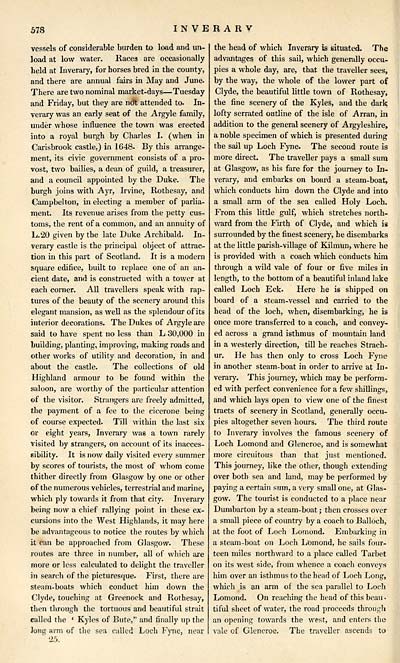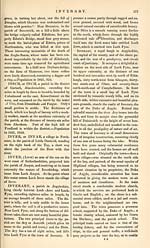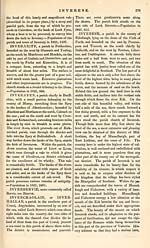Gazetteer of Scotland > Volume 2
(94) Page 578
Download files
Complete book:
Individual page:
Thumbnail gallery: Grid view | List view

578
INVERARV
vessels of considerable burden to load and un-
load at low water. Races are occasionally
held at Inverary, for horses bred in the county,
and there are annual fairs in May and June.
There are two nominal market-days — Tuesday
and Friday, but they are not attended to. In-
verary was an early seat of the Argyle family,
under whose influence the town was erected
into a royal burgh by Charles I. (when in
Carisbrook castle,) in 1648. By this arrange-
ment, its civic government consists of a pro-
vost, two bailies, a dean of guild, a treasurer,
and a council appointed by the Duke. The
burgh joins with Ayr, Irvine, Rothesay, and
Campbelton, in electing a member of parlia-
ment. Its revenue arises from the petty cus-
toms, the rent of a common, and an annuity of
L.20 given by the late Duke Archibald. In-
verary castle is the principal object of attrac-
tion in this part of Scotland. It is a modern
square edifice, built to replace one of an an-
cient date, and is constructed with a tower at
each corner. All travellers speak with rap-
tures of the beauty of the scenery around this
elegant mansion, as well as the splendour of its
interior decorations. The Dukes of Argyle are
said to have spent no less than L 30,000 in
building, planting, improving, making roads and
other works of utility and decoration, in and
about the castle. The collections of old
Highland armour to be found within the
saloon, are worthy of the particular attention
of the visitor. Strangers are freely admitted,
the payment of a fee to the cicerone being
of course expected. Till within the last six
or eight years, Inverary was a town rarely
visited by strangers, on account of its inacces-
sibility. It is now daily visited every summer
by scores of tourists, the most of whom come
thither directly from Glasgow by one or other
of the numerous vehicles, terrestrial and marine,
which ply towards it from that city. Inverary
being now a chief rallying point in these ex-
cursions into the West Highlands, it may here
be advantageous to notice the routes by which
it can be approached from Glasgow. These
routes are three in number, all of which are
more or less calculated to delight the traveller
in search of the picturesque. First, there are
steam-boats which conduct him down the
Clyde, touching at Greenock and Rothesay,
then through the tortuous and beautiful strait
called the ' Kyles of Bute," and finally up the
long arm of the sea called Loch Fyne, near
25.
the head of which Inverary is situated. The
advantages of this sail, which generally occu-
pies a whole day, are, that the traveller sees,
by the way, the whole of the lower part of
Clyde, the beautiful little town of Rothesay,
the fine scenery of the Kyles, and the dark
lofty serrated outline of the isle of Arran, in
addition to the general scenery of Argyleshire,
a noble specimen of which is presented during
the sail up Loch Fyne. The second route is
more direct. The traveller pays a small sum
at Glasgow, as his fare for the journey to In-
verary, and embarks on board a steam-boat,
which conducts him down the Clyde and into
a small arm of the sea called Holy Loch.
From this little gulf, which stretches north-
ward from the Firth of Clyde, and which is
surrounded by the finest scenery, he disembarks
at the little parish-village of Kilmun, where he
is provided with a coach which conducts him
through a wild vale of four or five miles in
length, to the bottom of a beautiful inland lake
called Loch Eck. Here he is shipped on
board of a steam-vessel and carried to the
head of the loch, when, disembarking, he is
once more transferred to a coach, and convey-
ed across a grand isthmus of mountain land
in a westerly direction, till he reaches Strach-
ur. He has then only to cross Loch Fyne
in another steam-boat in order to arrive at In-
verary. This journey, which may be perform-
ed with perfect convenience for a few shillings,
and which lays open to view one of the finest
tracts of scenery in Scotland, generally occu-
pies altogether seven hours. The third route
to Inverary involves the famous scenery of
Loch Lomond and Glencroe, and is somewhat
more circuitous than that just mentioned.
This journey, like the other, though extending
over both sea and land, may be performed by
paying a certain sum, a very small one, at Glas-
gow. The tourist is conducted to a place near
Dumbarton by a steam-boat ; then crosses over
a small piece of country by a coach to Balloch,
at the foot of Loch Lomond. Embarking in
a steam-boat on Loch Lomond, he sails four-
teen miles northward to a place called Tarbet
on its west side, from whence a coach conveys
him over an isthmus to the head of Loch Long,
which is an arm of the sea parallel to Loch
Lomond. On reaching the head of this beau-
tiful sheet of water, the road proceeds through
an opening towards the west, and enters the
vale of Glencroe. The traveller ascends to
INVERARV
vessels of considerable burden to load and un-
load at low water. Races are occasionally
held at Inverary, for horses bred in the county,
and there are annual fairs in May and June.
There are two nominal market-days — Tuesday
and Friday, but they are not attended to. In-
verary was an early seat of the Argyle family,
under whose influence the town was erected
into a royal burgh by Charles I. (when in
Carisbrook castle,) in 1648. By this arrange-
ment, its civic government consists of a pro-
vost, two bailies, a dean of guild, a treasurer,
and a council appointed by the Duke. The
burgh joins with Ayr, Irvine, Rothesay, and
Campbelton, in electing a member of parlia-
ment. Its revenue arises from the petty cus-
toms, the rent of a common, and an annuity of
L.20 given by the late Duke Archibald. In-
verary castle is the principal object of attrac-
tion in this part of Scotland. It is a modern
square edifice, built to replace one of an an-
cient date, and is constructed with a tower at
each corner. All travellers speak with rap-
tures of the beauty of the scenery around this
elegant mansion, as well as the splendour of its
interior decorations. The Dukes of Argyle are
said to have spent no less than L 30,000 in
building, planting, improving, making roads and
other works of utility and decoration, in and
about the castle. The collections of old
Highland armour to be found within the
saloon, are worthy of the particular attention
of the visitor. Strangers are freely admitted,
the payment of a fee to the cicerone being
of course expected. Till within the last six
or eight years, Inverary was a town rarely
visited by strangers, on account of its inacces-
sibility. It is now daily visited every summer
by scores of tourists, the most of whom come
thither directly from Glasgow by one or other
of the numerous vehicles, terrestrial and marine,
which ply towards it from that city. Inverary
being now a chief rallying point in these ex-
cursions into the West Highlands, it may here
be advantageous to notice the routes by which
it can be approached from Glasgow. These
routes are three in number, all of which are
more or less calculated to delight the traveller
in search of the picturesque. First, there are
steam-boats which conduct him down the
Clyde, touching at Greenock and Rothesay,
then through the tortuous and beautiful strait
called the ' Kyles of Bute," and finally up the
long arm of the sea called Loch Fyne, near
25.
the head of which Inverary is situated. The
advantages of this sail, which generally occu-
pies a whole day, are, that the traveller sees,
by the way, the whole of the lower part of
Clyde, the beautiful little town of Rothesay,
the fine scenery of the Kyles, and the dark
lofty serrated outline of the isle of Arran, in
addition to the general scenery of Argyleshire,
a noble specimen of which is presented during
the sail up Loch Fyne. The second route is
more direct. The traveller pays a small sum
at Glasgow, as his fare for the journey to In-
verary, and embarks on board a steam-boat,
which conducts him down the Clyde and into
a small arm of the sea called Holy Loch.
From this little gulf, which stretches north-
ward from the Firth of Clyde, and which is
surrounded by the finest scenery, he disembarks
at the little parish-village of Kilmun, where he
is provided with a coach which conducts him
through a wild vale of four or five miles in
length, to the bottom of a beautiful inland lake
called Loch Eck. Here he is shipped on
board of a steam-vessel and carried to the
head of the loch, when, disembarking, he is
once more transferred to a coach, and convey-
ed across a grand isthmus of mountain land
in a westerly direction, till he reaches Strach-
ur. He has then only to cross Loch Fyne
in another steam-boat in order to arrive at In-
verary. This journey, which may be perform-
ed with perfect convenience for a few shillings,
and which lays open to view one of the finest
tracts of scenery in Scotland, generally occu-
pies altogether seven hours. The third route
to Inverary involves the famous scenery of
Loch Lomond and Glencroe, and is somewhat
more circuitous than that just mentioned.
This journey, like the other, though extending
over both sea and land, may be performed by
paying a certain sum, a very small one, at Glas-
gow. The tourist is conducted to a place near
Dumbarton by a steam-boat ; then crosses over
a small piece of country by a coach to Balloch,
at the foot of Loch Lomond. Embarking in
a steam-boat on Loch Lomond, he sails four-
teen miles northward to a place called Tarbet
on its west side, from whence a coach conveys
him over an isthmus to the head of Loch Long,
which is an arm of the sea parallel to Loch
Lomond. On reaching the head of this beau-
tiful sheet of water, the road proceeds through
an opening towards the west, and enters the
vale of Glencroe. The traveller ascends to
Set display mode to: Large image | Transcription
Images and transcriptions on this page, including medium image downloads, may be used under the Creative Commons Attribution 4.0 International Licence unless otherwise stated. ![]()
| Gazetteers of Scotland, 1803-1901 > Gazetteer of Scotland > Volume 2 > (94) Page 578 |
|---|
| Permanent URL | https://digital.nls.uk/97431950 |
|---|
| Description | Volume II: Glenbanchor to Zetland. |
|---|---|
| Attribution and copyright: |
|
| Description | By Robert Chambers and William Chambers. Glasgow: Blackie & Son, 1838. 2 volumes. |
|---|---|
| Shelfmark | NF.1461.g.7 |
| Additional NLS resources: | |

